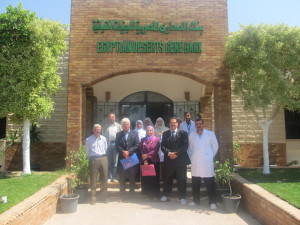- Wild veg are very much in the news today. Teresa Borelli and Danny Hunter are unlocking their potential.
- Meanwhile, Eileen Omosa actually has unlocked their potential. Here’s her take on Cleome gynandra (smoked out by Luigi’s photo of same).
- And then there are barberries, scourge of rust-susceptible wheat.
- Some trees, though, properly deployed, can be good for wheat. My head’s spinning with all that complexity.
- Saddest story you’ll read all day? Or most hopeful? A timeline of the status of the bison in North America.
- Seed degeneration to be studied. And about time too. Course, they don’t mean true seed. That never degenerates, not even in the
- World Vegetable Center’s spiffy genebank, whose database contains 438 species. As odd a way to advertise the database as any.
- And here’s a thought to strike terror into the hearts of genebank curators everywhere: plant genetic resources may not all be public goods after all, says noted expert Michael Halewood.
PGR and climate change: The video of the book
Twenty years ago there was Climatic Change and Plant Genetic Resources. Now there is, ahem, Plant Genetic Resources and Climate Change. If you don’t have the $120-odd for the book, you can always watch the 30-odd minute video. Actually, both are well worth it.
Deserts genebank rises from ashes
Some good news from the Egypt Deserts Gene Bank. This just in from its head, Dr Mohamed Amar:
The EDGB was looted and much valuable equipment destroyed during the uprisings in Egypt in February 2011. One of my key tasks was to rebuild the gene bank and increase its international network and collaborative research. Therefore, great funding was allocated from the budget of the Desert Research Center for the rehabilitation of the bank, to better than it was. In April 2013, the Egyptian Desert Gene Bank was reopened in the presence of senior leaders of the Desert Research Center and the governor of North Sinai. All equipment has been updated according to the latest standards. At the same time, we have been provided many scholarships for staffs outside Egypt, in China and other countries, as part of the rehabilitation of human resources.
We wish them all the best.
Nibbles: IK, Magi, Yield gap maps, ICRISAT DG, Maize and drought, Phenotyping workshop, Clone epigenetics, Root & tubers, Botanical social networking, Mexican archaeobotany, LOTW
- Intergovernmental Platform on Biodiversity and Ecosystem Services documents examples of how indigenous people’s knowledge conserves biodiversity, including of the agricultural kind.
- The truth about frankincense and myrrh. Talk about traditional knowledge.
- Can global crop production meet future demands? The Story Map.
- What ICRISAT is doing about the above, from the horse’s mouth.
- Progress in Achieving and Delivering Drought Tolerance in Maize — An Update: “Germplasm collections are assuming greater importance if gains from native genes are to be sustained. Efficient and accurate field phenotyping remains essential for genetic progress.”
- Workshop in Field-based High Throughput Phenotyping. Next April, in Arizona, you maize people.
- A clone is a clone is… no wait.
- Root and tuber people already planning their next big shindig, in October 2015. Meanwhile, they’re getting down to work in the Pacific.
- AoB Blog on plant science on Facebook. Also on Facebook.
- Solanum expert Dr Sandy Knapp on the of Global Plants Initiative.
- Archaeological remains of agriculture found in Nuevo Leon are oldest for that Mexican state.
- Legumes (genera) of the world now online, thanks to Kew.
Brainfood: Gaming landuse decisions, Natura 2000, Expressing pears, Medicinal rice, Agroforestry and conservation, Grasslands, Cotton diversity, Ancient cattle, Neolithic Balkans, Indian guar
- Gaming for smallholder participation in the design of more sustainable agricultural landscapes. Board game can be used to facilitate communal decision-making in landuse planning in the buffer zone of a Man and Biosphere Reserve. What’s not to like?
- Mixed effects of long-term conservation investment in Natura 2000 farmland. It has been good for some things, not so good for others. No word on how CWRs have fared.
- Microarray analysis of gene expression patterns during fruit development in European pear (Pyrus communis). They’re different to those of Japanese pear (Pyrus pyrifolia).
- Quantitative and molecular analyses reveal a deep genetic divergence between the ancient medicinal rice (Oryza sativa) Njavara and syntopic traditional cultivars. Njavara is a cryptic variant of traditional Kerala varieties.
- Relationships between Biodiversity and Biological Control in Agroecosystems: Current Status and Future Challenges. Management should aim to suppress pests while maintaining diversity of natural enemy guilds. Easier said than done, I suspect.
- Agroforestry and Biodiversity Conservation in Tropical Landscapes. Between agroforestry cause and conservation effect are a bunch of pesky assumptions. I wonder if gaming would help.
- Livestock grazing and biodiversity in semi-natural grasslands. It can be good. Just one paper in the proceedings of a recent major conference on grasslands.
- Genetic diversity and population structure in the US Upland cotton (Gossypium hirsutum L.). Who needs wild relatives when you have diverse obsolete varieties?
- Morphological and genetic evidence for early Holocene cattle management in northeastern China. Archaeology and DNA suggest parallel domestication of cattle in China.
- Domesticated Animals and Biodiversity: Early Agriculture at the Gates of Europe and Long-term Ecological Consequences. For thousands of years the impact of agriculture in the Balkans was limited.
- Characterization of released and elite genotypes of guar [Cyamopsis tetragonoloba (L.) Taub.] from India proves unrelated to geographical origin. And?
